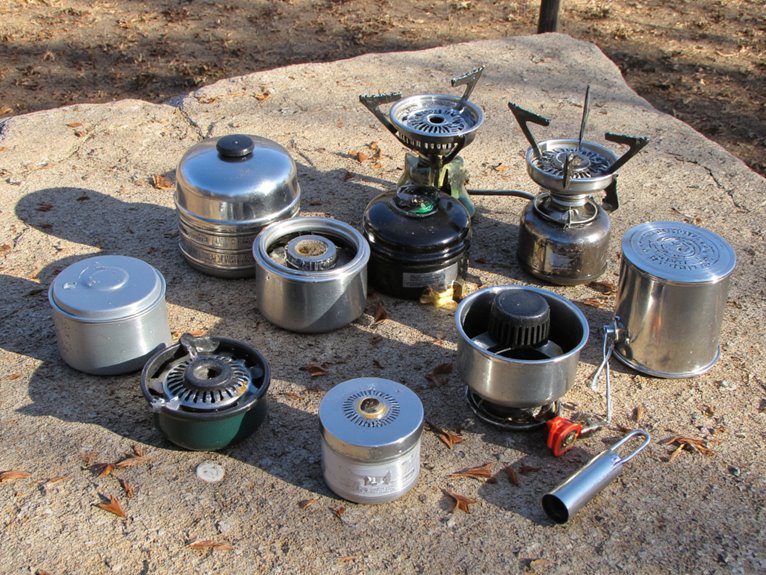Are Inflatable Boats Worth It?
Inflatable boats offer a unique combination of affordability, portability, and versatility that makes them an attractive option for many water enthusiasts. They are lightweight, easy to transport, and require minimal maintenance. With a lower initial investment cost compared to traditional boats, they provide a convenient and cost-effective solution for those who want to enjoy water activities without breaking the bank. While durability concerns and performance in rough waters are important considerations, the benefits of inflatable boats make them a worthy investment for many. Investigate the advantages and limitations of inflatable boats to determine if they're right for you.
We are supported by our audience. When you purchase through links on our site, we may earn an affiliate commission, at no extra cost for you. Learn more. Last update on 24th December 2025 / Images from Amazon Product Advertising API.
Inflatable Boat Pros and Cons
Inflatable boats offer several benefits, including their lightweight and portable design, making them easy to transport and store.
They are also relatively affordable and require minimal maintenance.
Additionally, inflatable boats are highly versatile, suitable for a range of water activities, from fishing to water sports.
On the downside, they may not be as sturdy as traditional boats and can be prone to punctures.
In addition, their performance may not be as smooth as traditional boats, and they may not handle rough waters as well.
Despite these drawbacks, inflatable boats remain a popular choice for many water enthusiasts due to their convenience and affordability.
Durability Concerns and Lifespan
Despite their many advantages, one of the primary concerns with inflatable boats is their durability, with many owners wondering how long their investment will last.
The lifespan of an inflatable boat largely depends on the quality of construction, materials used, and maintenance practices.
On average, a well-maintained inflatable boat can last for around 10 to 15 years. However, this can vary substantially depending on factors such as exposure to UV rays, saltwater, and storage conditions.
Regular inspections, proper storage, and adherence to manufacturer guidelines can notably extend the lifespan of an inflatable boat.
Performance in Rough Waters
When traversing rough waters, the stability and maneuverability of an inflatable boat become paramount, as even slight instability can compromise safety and impede progress.
Inflatable boats are designed to absorb shock and maintain stability, making them well-suited for traversing choppy waters.
The flexible hull of an inflatable boat allows it to conform to wave patterns, reducing the impact of each wave and providing a smoother ride.
Additionally, the lightweight design and responsive handling of inflatable boats enable quick turns and agile maneuverability, allowing you to maintain control in turbulent conditions.
Storage and Transportation Benefits
Inflatable boats offer unparalleled convenience regarding storage and transportation, as their lightweight and compact design allows for effortless deflation and stowage in small spaces.
This feature is particularly beneficial for those with limited storage capacity or those who need to transport their boat frequently.
Some key advantages of inflatable boats regarding storage and transportation are:
Easy to deflate and store: Inflatable boats can be deflated and stored in a small area, making them ideal for those with limited storage space.
Lightweight and compact: Their lightweight design makes them easy to transport, even for those without a large vehicle.
Easy to maneuver: Inflatable boats are easy to maneuver, even in tight spaces, making them perfect for small docks or tight storage areas.
Reduced towing requirements: Their lightweight design reduces the need for heavy-duty towing equipment, making transportation even more convenient.
Cost Comparison to Traditional Boats
When considering the cost-effectiveness of inflatable boats, we must examine the initial investment costs, ongoing maintenance expenses, and long-term durability in comparison to traditional boats.
A thorough analysis of these factors reveals that inflatable boats offer significant cost savings, making them an attractive option for boat enthusiasts.
Initial Investment Costs
Compared to traditional boats, the initial investment costs of inflatable boats are substantially lower, with prices ranging from a few hundred to several thousand dollars.
This significant cost difference is primarily due to the materials used and the manufacturing process. Inflatable boats are made from durable, lightweight materials, which reduce production costs.
Material costs: Inflatable boats are made from durable, lightweight materials that are less expensive than traditional boat-building materials.
Manufacturing process: The manufacturing process for inflatable boats is less labor-intensive and requires less equipment, resulting in lower production costs.
No need for a trailer: Inflatable boats are often lighter and more compact, eliminating the need for a trailer, which can save thousands of dollars.
Simplified design: Inflatable boats have a simpler design, which reduces the cost of construction and assembly.
Ongoing Maintenance Expenses
Beyond the initial investment, ongoing maintenance expenses are a crucial aspect to ponder when evaluating the cost-effectiveness of inflatable boats versus traditional vessels.
Inflatable boats generally require less maintenance compared to traditional boats, primarily due to their simplicity in design and construction.
The lack of intricate mechanical systems and absence of a hull that requires painting and waxing reduce the need for frequent servicing.
Additionally, inflatable boats tend to be lighter, making them easier to trailer and store, which further reduces maintenance costs.
On average, inflatable boat owners can expect to save around 20-30% on annual maintenance expenses compared to traditional boat owners.
This cost savings can add up over time, making inflatable boats an attractive option for those seeking a more affordable boating experience.
Long-Term Durability
Inflatable boats, particularly those made from high-quality materials, have been shown to last for 10 to 15 years or more, with some owners reporting a lifespan of up to 20 years, which rivals the durability of traditional boats.
In terms of cost comparison, inflatable boats offer a significant advantage.
Lower upfront cost: Inflatable boats are often less expensive to purchase than traditional boats.
Reduced maintenance costs: Inflatable boats require less maintenance, which translates to lower costs over time.
Longer lifespan: As mentioned, inflatable boats can last up to 20 years or more, reducing the need for frequent replacements.
Resale value: Inflatable boats retain their value well, making them a worthwhile investment.
Inflatable Boat Maintenance Needs
Regular inspections and routine cleaning are essential to extend the lifespan of an inflatable boat and prevent costly repairs.
A weekly wipe-down with a mild soap solution and freshwater rinse can help remove dirt and grime that can compromise the material.
Additionally, inspect the boat's seams, valves, and transom for signs of wear or damage.
Perform a more thorough inspection every three months, checking for cracks, blisters, or soft spots on the hull.
Verify the boat is properly dried and stored in a cool, dry place when not in use.
Adhere to the manufacturer's recommended maintenance schedule and guidelines for cleaning and storing the boat to maintain its performance and longevity.
Safety Features and Concerns
One of the most critical aspects of owning an inflatable boat is ensuring it is equipped with essential safety features to minimize risks and prevent accidents.
When selecting an inflatable boat, it is crucial to consider the safety features that come with it.
Stable and balanced design: Ensures the boat remains stable in various water conditions.
Visible and durable markings: Clearly marked with reflective materials for increased visibility.
Multiple air chambers: Redundancy in case of puncture or damage.
Grab lines and handles: Easy access and secure holding points.
Customization and Accessory Options
In terms of customization and accessory options, inflatable boats offer a range of possibilities to tailor your vessel to your specific needs.
One key area of customization is the seating and flooring, with various options available to suit different user preferences and activities.
Additionally, the choice of motor and propeller can greatly impact the performance and handling of your inflatable boat, with different combinations suited to different applications.
Seat and Floor Options
Typically, inflatable boats offer a range of seat and floor options, allowing owners to customize their vessel to suit their specific needs and preferences.
This flexibility is particularly useful for anglers, water sports enthusiasts, and families, who require different configurations to accommodate their activities.
Some popular seat and floor options include:
Bench seats: ideal for fishing and cruising.
Fold-down seats: convenient for storage and transportation.
Removable floorboards: easy to clean and maintain.
Inflatable floors: lightweight and compact for small vessels.
Motor and Propeller Choices
Five key motor and propeller choices enable owners to tailor their inflatable boat's performance, efficiency, and handling to their specific needs and boating styles.
To begin with, short-shaft or long-shaft motors can be selected, depending on the boat's transom height.
Next, propeller material options include aluminum, stainless steel, or bronze, each with its own durability and corrosion resistance characteristics.
Additionally, propeller pitch and diameter can be customized to optimize speed, acceleration, or fuel efficiency.
Moreover, owners can choose between two-stroke or four-stroke engines, considering factors like power, weight, and environmental impact.
In addition, electric motors offer a quiet, eco-friendly alternative for smaller vessels.
Inflatable Boat Types and Sizes
Several types of inflatable boats cater to diverse needs and preferences, ranging from compact, portable options to spacious, heavy-duty vessels.
When selecting an inflatable boat, it's essential to weigh the intended use, number of passengers, and storage constraints.
Some popular types of inflatable boats include:
- Tender boats: Compact and lightweight, ideal for small lakes or calm seas.
- Pontoon boats: Spacious and stable, suitable for fishing or cruising.
- RIBs (Rigid Inflatable Boats): High-performance vessels for thrill-seekers and water sports enthusiasts.
- Fishing inflatables: Specialized boats with features like built-in rod holders and livewells.
Understanding the different types and sizes of inflatable boats helps you take the plunge and choose the perfect fit for your needs, ensuring a safe and enjoyable experience on the water.
Real-Life Owner Experiences
Inflatable boat owners have shared their real-life experiences, providing valuable insights into the pros and cons of owning one of these vessels.
From performance issues to durability concerns, these firsthand accounts offer a candid look at the realities of inflatable boat ownership.
Real-life owners of inflatable boats share their experiences, highlighting the advantages and disadvantages of these vessels, which can greatly inform potential buyers' decisions.
These owners often praise the convenience and portability of inflatable boats, as well as their affordability and ease of storage. However, some owners also report issues with durability and stability, citing concerns about punctures and damage to the hull.
Some key takeaways from owner experiences include:
- Easy to transport and store: Inflatable boats are lightweight and compact, making them easy to take on the go.
- Affordable: Inflatable boats are often more budget-friendly than traditional fiberglass boats.
- Convenient: Inflatable boats can be quickly inflated and deflated, making them ideal for spontaneous outings.
- Durability concerns: Some owners report issues with punctures and damage to the hull, highlighting the need for regular maintenance and care.
Boat Performance Issues
While owners appreciate the convenience and affordability of inflatable boats, some have reported performance issues that can impact their overall boating experience.
One common complaint is the reduced speed and maneuverability compared to traditional boats. Inflatable boats can be sluggish, making it difficult to quickly respond to changing wind or water conditions.
Additionally, their lightweight construction can make them prone to drifting or being pushed off course.
Some owners have also reported issues with the inflatables' tendency to 'porpoise' or bounce excessively in choppy waters, which can be uncomfortable for passengers.
These performance issues can be frustrating for owners, particularly those who prioritize speed and agility.
Durability Concerns Raised
Owners who have spent extensive time on the water have voiced concerns about the durability of inflatable boats, citing instances of torn seams, cracked floors, and faded decals that compromise the overall structural integrity of the vessel. These issues can lead to costly repairs, downtime, and even safety risks.
Some common durability concerns include:
- UV damage: Prolonged exposure to sunlight can cause the material to degrade, leading to cracks and fading.
- Material fatigue: Repeated inflation and deflation can cause the material to weaken, leading to tears and punctures.
- Moisture damage: Water absorption can cause the material to become heavy, leading to performance issues and further damage.
- Poor manufacturing: Subpar construction can lead to premature wear and tear, reducing the lifespan of the boat.
It's essential to carefully consider these concerns when deciding if an inflatable boat is right for you.






